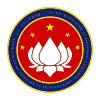Yuwa-Kati
Yuwa-Kati Região Semi-Autônoma de Yuwa-Kati (Portuguese) ユワ・カティ半自治区 (Japanese) полуавтономный район юва-кати (Russian) | |
|---|---|
Semi-autonomous region | |
| Yuwa-Kati Semi-Autonomous Region | |
| Motto: Apes together strong | |
| Sovereign state | |
| Annexation from Russia | 18 December 2022 |
| Named for | iwa'kati |
| Official languages | Portuguese English Japanese Russian |
| Demonym(s) | Yuwakatian |
| Government | |
• Governor | N/A |
| Area | |
• Total | 2.6 km2 (1.0 sq mi) |
| Highest elevation | 146 m (479 ft) |
| Population | |
• Estimate | 0 |
| Date format | dd/mm/yyyy |
| Driving side | right |
Yuwa-Kati or Yuwa Kati, officially the Yuwa-Kati Semi-Autonomous Region (YKSAR) (Portuguese: Região Semi-Autônoma de Yuwa-Kati, Japanese: ユワ・カティ半自治区, Russian: полуавтономный район юва-кати) is a Semi-Autonomous Region of Forestia located in the Eugénie Archipelago within the Sea of Japan. With an area of 2.6 square kilometres (1.0 square mile), Yuwa-Kati is the largest Forestian territory. However, the island does not possess permanent inhabitants, making it the least populated state of Forestia and the only one without a fixed population.
Originally administratively part of the Russian city of Vladivostok, the island was annexed as an incorporated territory of Forestia on 18 December 2022 as part of a series of territorial annexations being made by the Forestian government.
Etymology
The name for Yuwa-Kati comes from the guarani term iwa'kati or i'ba-ka'ti, which means "fruit that smells great".[1] The term is also the origin for the portuguese word for pineapple (abacaxi).
History
The state of Yuwa-Kati is located in the Empress Eugénie Archipelago, off the coast of Russia. It was annexed from Russia on December 18, 2022.
Yuwa-Kati has a long and complex history, with roots that can be traced back to the indigenous peoples who lived on the islands for centuries. The first recorded European contact with the archipelago came in the 18th century, when Russian explorers arrived and claimed the islands as part of the Russian Empire.
Annexation
The territory of Yuwa-Kati was annexed to Forestia from Russia on 18 December 2022.
Geography
Yuwa-Kati is located in the Eugénie Archipelago of the Peter the Great Gulf. The island is surrounded by the Sea of Japan. The island is located about 1,300 kilometers (810 miles) northeast of the city of Yuzhno-Sakhalinsk, the capital of the Sakhalin Oblast region. The island is primarily volcanic in origin, with a rugged and mountainous terrain. Its highest point is Mount Stokap, which rises to an elevation of 737 meters (2,418 feet) above sea level. The island's coastline is rocky and indented, with several bays and inlets.
Climate
Yuwa-Kati has a humid continental climate, with cold and dry winters and warm and humid summers. The average high temperature during the summer months of June to August ranges from 18-20°C (64-68°F), while the average low temperature during the winter months of December to February ranges from -10 to -12°C (14-16°F). The city experiences a significant amount of precipitation throughout the year, with most of it falling during the summer months. Snowfall is common during the winter season, and the region is known for its strong winds, particularly during the winter months.
Flag
The flag of Yuwa-Kati is based on a proposed flag of Macau, which had the shade of red changed.


